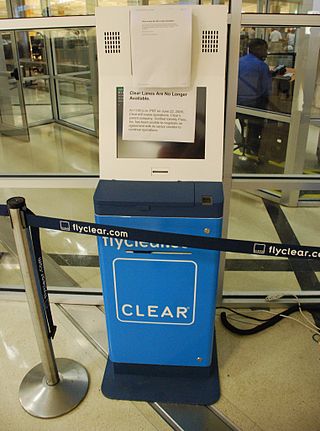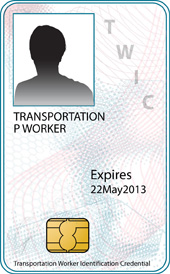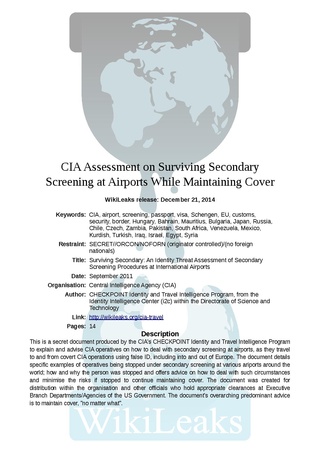After the September 11 attacks, there was an immediate call to action regarding the state of aviation security measures as the hijackers involved in 9/11 were able to successfully pass through security and take command of the plane. The existing security measures flagged more than half of the 19 hijackers in 9/11; however, they were cleared to board the plane because their bags were not found to contain any explosives. In the months and years following September 11, 2001, security at many airports worldwide were reformed to deter similar terrorist plots.

The Transportation Security Administration (TSA) is an agency of the United States Department of Homeland Security (DHS) that has authority over the security of transportation systems within, and connecting to the United States. It was created as a response to the September 11 attacks to improve airport security procedures and consolidate air travel security under a dedicated federal administrative law enforcement agency.

Airport security includes the techniques and methods used in an attempt to protect passengers, staff, aircraft, and airport property from malicious harm, crime, terrorism, and other threats.
The Computer-Assisted Passenger Prescreening System is a counter-terrorism system in place in the United States air travel industry. The United States Transportation Security Administration (TSA) maintains a watchlist, pursuant to 49 USC § 114 (h)(2), of "individuals known to pose, or suspected of posing, a risk of air piracy or terrorism or a threat to airline or passenger safety." The list is used to pre-emptively identify terrorists attempting to buy airline tickets or board aircraft traveling in the United States, and to mitigate perceived threats.
The No Fly List, maintained by the United States federal government's Terrorist Screening Center (TSC), is one of several lists included in algorithmic rulesets used by government agencies and airlines to decide who to allow to board airline flights. The TSC's No Fly List is a list of people who are prohibited from boarding commercial aircraft for travel within, into, or out of the United States. This list has also been used to divert aircraft away from U.S. airspace that do not have start- or end-point destinations within the United States. The number of people on the list rises and falls according to threat and intelligence reporting. There were reportedly 16,000 names on the list in 2011, 21,000 in 2012, and 47,000 in 2013.

A registered traveler is a person qualified through an airline passenger security assessment system in the United States air travel industry. Such programs were initially tested in 2005. Registered traveler programs are currently in operation in various airports around the country, and are administered by TTAC, the Transportation Security Administration (TSA) office responsible for Secure Flight, the replacement for the Computer Assisted Passenger Prescreening System (CAPPS) and the canceled CAPPS II counter-terrorism system. Registered Traveler is a public and private partnership between the TSA and the Registered Traveler Interoperability Consortium (RTIC) providing rules and standards for private Enrollment Providers that sign up participants. The largest registered traveler program is called Clear, and is operated by Clear Secure, Inc. The Clear access clearance service is currently operating at 60 airports, airports, stadiums, and other venues nationwide as of January 2020.

The Federal Air Marshal Service (FAMS) is a United States federal law enforcement agency under the supervision of the Transportation Security Administration (TSA) of the United States Department of Homeland Security (DHS).
Security theater is the practice of taking security measures that are considered to provide the feeling of improved security while doing little or nothing to achieve it.

The Intelligence Reform and Terrorism Prevention Act of 2004 (IRTPA) is a 235-page Act of Congress, signed by President George W. Bush, that broadly affects United States federal terrorism laws. The act comprises several separate titles with varying subject issues. It was enacted in response to the terror attacks of September 11, 2001.
The Computer Assisted Passenger Prescreening System II was a program of the United States Department of Homeland Security (DHS) instituted to increase security at airports by assessing the risk level of passengers before they're allowed to board. CAPPS II searched through information stored in government and commercial databases and assigned a color-coded level of risk to each passenger. Amid controversy from such organizations as the American Civil Liberties Union (ACLU), the Electronic Privacy Information Center (EPIC), and the Electronic Frontier Foundation (EFF), the program was terminated by President Bush in August 2004. The program was then replaced by a similar program called Secure Flight in early 2005 generating the same concerns over privacy and civil liberties. However, due to public concerns, Secure Flight did not become operational until 2010. CAPPS II grounded innocent Americans due to false positives. One notable example is the grounding of Senator Ted Kennedy in 2004.

The Transportation Worker Identification Credential program is a Transportation Security Administration and U.S. Coast Guard initiative in the United States. The TWIC program provides a tamper-resistant biometric credential to maritime workers requiring unescorted access to secure areas of port facilities, outer continental shelf facilities, certain manufacturing facilities, and vessels regulated under the Maritime Transportation Security Act of 2002, or MTSA, and all U.S. Coast Guard credentialed merchant mariners. As of May 2014, there were 2,999,058 people enrolled in the program. Those seeking unescorted access to secure areas aboard affected vessels, and all Coast Guard credentialed merchant mariners, must obtain a TWIC. The new measures were fully implemented on April 15, 2009. To obtain a TWIC, an individual must provide biographic and biometric information such as fingerprints, sit for a digital photograph and successfully pass a security threat assessment conducted by TSA.

A Federal Flight Deck Officer (FFDO) is a Part 121 Airline Pilot who is trained and licensed to carry weapons and defend commercial aircraft against criminal activity and terrorism. The Federal Flight Deck Officer program is run by the Federal Air Marshal Service, and an officer's jurisdiction is the flight deck or cabin of a commercial airliner or a cargo aircraft while on duty. FFDOs are federal law enforcement officers sworn and deputized by the U.S. Department of Homeland Security.
The Alien Flight Student Program is a program operated by the United States Transportation Security Administration to screen prospective flight student candidates who are not citizens of the United States, before they are allowed to undergo pilot training. This program was created in response to the September 11, 2001 attacks, in recognition of the fact that the individuals who piloted the hijacked aircraft first learned to fly at US flight schools.

Sensitive Security Information (SSI) is a category of sensitive but unclassified information under the United States government's information sharing and control rules. SSI is information obtained in the conduct of security activities whose public disclosure would, in the judgement of specified government agencies, harm transportation security, be an unwarranted invasion of privacy, or reveal trade secrets or privileged or confidential information. SSI is governed by Title 49 of the Code of Federal Regulations (CFR), parts 15 and 1520.

Secondary Security Screening Selection or Secondary Security Screening Selectee, known by its initials SSSS, is an airport security measure in the United States which selects passengers for additional inspection. People from certain countries are subject to it by default. The passengers may be known as Selectee, Automatic Selectee or the Selectee list. The size and contents of the list fluctuates and is a secret, although the Transportation Security Administration has stated there are tens of thousands of names on it.
Passenger Protect, commonly referred to as the Canadian no-fly list, is the Canadian government initiative to identify individuals who may be an "immediate threat to aviation security" and prevent them from boarding a flight.

Sensitive Security Information or SSI is a term used in the United States to denote sensitive but unclassified information obtained or developed in the conduct of security activities, the public disclosure of which would constitute an unwarranted invasion of privacy, reveal trade secrets or privileged or confidential information, or be detrimental to the security of transportation. It is not a form of classification under Executive Order 12958 as amended. SSI is not a security classification for national security information. The safeguarding and sharing of SSI is governed by Title 49 Code of Federal Regulations (CFR) parts 15 and 1520. This designation is assigned to information to limit the exposure of the information to only those individuals that "need to know" in order to participate in or oversee the protection of the nation's transportation system. Those with a need to know can include persons outside of TSA, such as airport operators, aircraft operators, railroad carriers, rail hazardous materials shippers and receivers, vessel and maritime port owners and operators, foreign vessel owners, and other persons.
In response to the September 11, 2001 attacks on the World Trade Center in New York City, the United States Department of Homeland Security (DHS) implemented new rules to ensure the safety of domestic and international air travel in the United States. The rules of this program are administered by the Transportation Security Administration (TSA), who is responsible for the oversight of all transportation security, including truck, rail and ocean, as well as air.
The concept of border security in the United States shares a complex relationship with the persistent threat of terrorism. Border security includes the protection of land borders, ports, and airports. The relationship is unique in the sense that the federal government must constantly reevaluate and tweak its border security policy to address the perceived threats posed to the United States through the form of human terrorism or the smuggling and detonation of a weapon of mass destruction.
The Traveler Redress Inquiry Program is a program managed by the Department of Homeland Security in the United States that allows people who face security-related troubles traveling by air, receive excessive security scrutiny, or are denied entry to the United States, to file their grievances with and seek redress from the DHS.








